Blue Jays Series Preview: Stroman vs. Archer kicks off the 2016 campaign

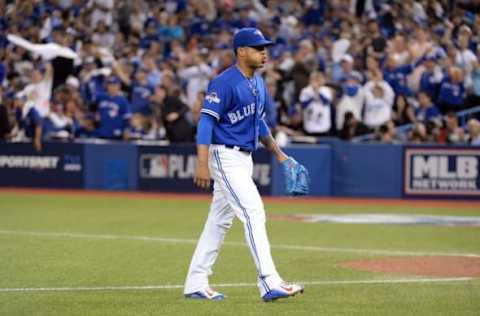
The day we’ve all been impatiently waiting for all winter long has finally arrived, opening day is upon us. After their first playoff appearance in 22 years and entering the year with a roster loaded with talent, the excitement surrounding the Jays is incredibly high.
That excitement that the fans feel is mimicked by the players themselves, and at the forefront of that is their opening day starting pitcher, 24-year-old Marcus Stroman. Oozing with ability, constantly showing his emotion, and treating every game like it’s his last, Stroman is the epitome of excitement in baseball.
Opposing him on opening day is the Rays own version of that in Chris Archer, who is becoming one of the faces of the MLB for his appearances both on and off the field. Both starters possess fastballs that can get into the mid-90’s and array of pitches that can downright dominate opponents. You can’t ask for a better pitching match up on opening day.
The Rays have always given the Jays trouble, as they posted losing records against them for six straight years between 2008 and 2013 before breaking that trend in 2014 (11-8); however, they fell back into the trend last year going 9-10, including 3-6 at Tropicana.
Six of those losses came in the first seven games, all of them coming in a sluggish April for the Jays. They went 8-4 the rest of the way, including 5 straight wins in the second half.
Next: Sizing up the Tampa Bay Rays
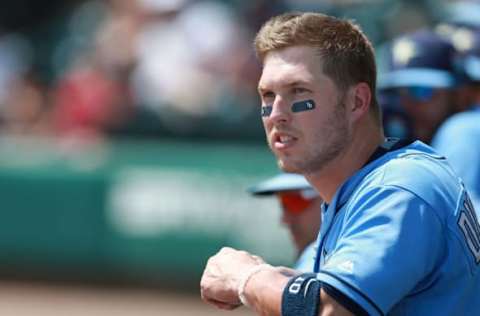
Across the Diamond
For those that are choosing the Rays as a potential surprise team in the AL East, I don’t see it. I really like their rotation; it’s young, it’s very talented, it’s fairly experienced for how youthful it is, and if Matt Moore can return to a form similar to his pre-TJ form, it will be very strong. However, Drew Smyly and Jake Odorizzi battled injuries last year to join the injury risk in Moore. Although Blake Snell looks nearly ready to produce at the MLB level and he can be a solid injury replacement.
The bullpen looks thin, especially after the Brad Boxberger injury. Alex Colome should be able to step into the closer role admirably, as he dominated out of the pen last year with a 2.66 ERA, 1.71 FIP and 9.74 K/9. Xavier Cedeno and Ryan Webb were fairly reliable last year, while Danny Farquhar and Enny Romero offer some upside in the K/9 department but are coming off shaky 2015 seasons. It’s hardly a bullpen that can consistently shut down offences, and won’t be feared by opposing lineups.
More from Jays Journal
- Matt Chapman has been exactly what the Blue Jays needed
- Blue Jays: The goalposts are moving in the right direction
- Single-A Dunedin Blue Jays advance to the Championship Series
- Blue Jays: Comparisons for Alek Manoah’s Second Season
- Blue Jays: Adam Cimber, the unlikely decision King
The lineup is fairly balanced, with solid hitters in Logan Forsythe, Evan Longoria, and Corey Dickerson near the top of the order, but that trio will hardly strike fear into opposing pitchers. Those three guys will need to stay healthy and produce, while the rest of lineup will need to produce some unforeseen breakouts in order for them to compete offensively.
Desmond Jennings, Logan Morrison, Hang Conger, Brad Miller, Steven Souza Jr., and their best player, Kevin Kermaier, are all average to below average at the dish, and barring a large breakout from one or two of them, I don’t see their offence being able to put up enough runs.
As a team, they ranked fifth in Fangraphs defensive WAR, sixth in UZR, and 14th in DRS, but that was largely on the strength of Kermaier’s excellence in CF. Conger is an elite pitch framer, Forsythe is solid at 2B, Longoria is no longer the elite defensive 3B anymore, but he’s solid, and the OF can cover some ground, but I wouldn’t refer to their team defence as one of the best in the league. In fact, I prefer the Jays for being significantly better at SS, 2B, and C.
With strong pitching, that lineup can win some games, but I see them as a team similar to their 2015 squad. They’ll battle for .500 and they’ll be a pesky team to play, but I see them as a good match up for the Jays when looking at the big picture.
Next: Game 1: Stroman vs. Archer: Should be fun
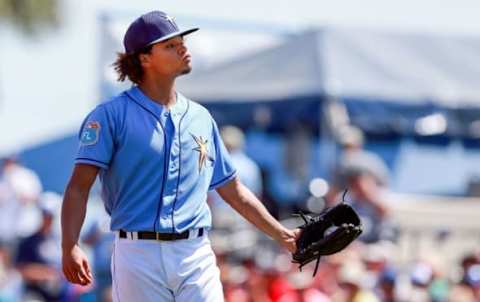
Game #1: April 3, 2016 – 4:05 ET
Marcus Stroman (4-0, 1.67 ERA, 3.54 FIP) vs.
Chris Archer (12-13, 3.23 ERA, 2.90 FIP)
The aforementioned opening day matchup is a good one, but while both of these pitchers offer immense talent, they attack hitters in distinctly different ways.
Archer is coming off his best season, putting up a 5.3 fWAR, and he is a pure power pitcher, using his 96.11 mph 4-seam fastball 54.19% of the time and his 88.63 mph slider 39.22%. Against RHH, he completely abandons his changeup, as he becomes a two pitch pitcher, but those two pitches are so dominant he can get away with the lack of diversity. Against LHH he’ll use his change about 12% of the time, offering a bit of a more diverse look.
He doesn’t have a varied set of pitches, but all three of them garner plenty of swing and misses, and his slider can be virtually untouchable at times. He gets into trouble when his fastball location isn’t there, and he gets into hitters counts, letting the opposition sit on fastball, but when he’s on, his 4-seam/slider mix is dynamite.
Stroman offers a completely different look. His 4-seam and slider are nearly 3 mph slower (93.29 and 86.43), so he doesn’t offer the same kind of power that Archer does, but his repertoire is far more diverse. He throws six different pitches (4-seam, sinker, cutter, curve, slider, change) and uses 5 of them at least 10% of the time. The pitch being used the least is his 4-seam (5.04%), as he’s become reliant on his effective sinker. His change is largely just a show-me pitch that he throws to LHH at this point, but the rest of his arsenal he can use in any count and any location.
Instead of relying on two dominant offerings to get whiffs like Archer, he is adept at mixing speeds and location in order to keep hitters off balance and generate weak contact.
Archer faced the Jays a total of six times in 2015 (15 for his career), absolutely picking them apart in his first four starts, going a combined 29 innings while giving up 12 hits, and just three ER. However, in September, the Jays got to him for 9 ER through 3.1 IP. Familiarity is absolutely there for the Jays, but this is a pitcher that has proven he can shut down some of the Jays big bats.
Stroman on the other hand has only faced the Rays twice, both times coming in 2014, so a lack of familiarity for many of the Rays hitters should play to Stroman’s advantage.
Next: Game 2: Jays look to attack Smyly
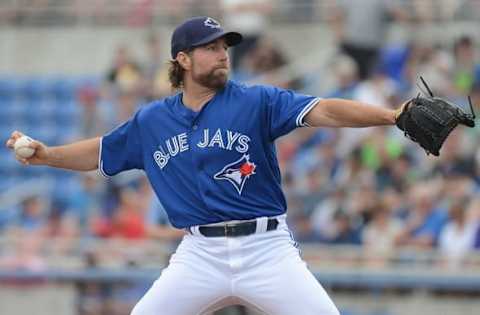
Game #2: April 4, 2016 – 7:10 ET
R.A. Dickey (11-11, 3.91 ERA, 4.48 FIP) vs.
Drew Smyly (5-2, 3.11 ERA, 3.91 FIP)
The Stroman-Archer match up has the looks of a low-scoring pitchers duel, and I can’t see this one being the same. It’s tough enough to limit the Jays explosive offence once, but doing it two days in a row is a tall task.
Smyly offers an array of plus pitches from the left side, and had a lot of success missing bats when he was healthy in 2015 (10.40 K/9), but he struggled with home runs (1.49 HR/9), and the Jays hammer left-handed pitching. I mean, they absolutely hammer it.
Toronto led the league last season in wRC+ against LHP with a mark of 124, while also placing first in OBP, SLG, ISO, and BB/K. Their offence was by far the best last year, but it was downright unfair against LHP. I don’t envision the fly-ball prone Smyly, who has fairly heavy LHP/RHP splits, having a fun time against the Jays.
There isn’t much to be said about Dickey. In terms of repertoire, experience, familiarity with the Rays and Tropicana, you pretty much know what to expect. The knuckle is either there or it isn’t, and there isn’t a large space for him to fall in between.
There is a general perception that Dickey loves pitching at Tropicana and he fairs well there, but in the last two years, he’s actually struggled at the Trop and against the Rays in general, especially in 2015. It’s basically a toss-up trying to predict how Dickey will perform, but with a solid spring under his belt and with the knuckler looking good you hope he can deliver a quality start and let the offense take control of this one.
Next: Game 3: Sanchez looks to build off strong spring
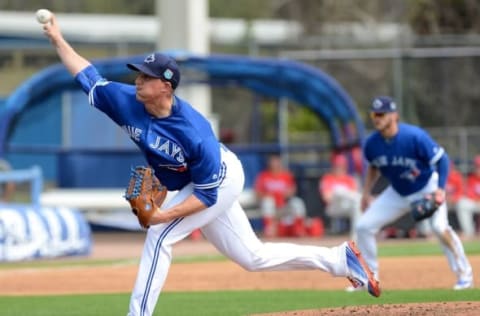
Game #3: April 5, 2016 – 7:10 ET
Aaron Sanchez (7-6, 3.22 ERA, 4.61 FIP) vs.
Jake Odorizzi (9-9, 3.35 ERA, 3.61 FIP)
The assumption is being made that Sanchez will be the game 3 starter, as he’s best suited to follow Dickey in the rotation, but this has not been confirmed by John Gibbons as of yet.
The stats from Sanchez’s 2015 season are tough to gauge, as he split 2015 back and forth between the rotation and bullpen, causing his starting sample to be small. His starting numbers don’t entice optimism, and the peripherals aren’t the prettiest, but his final four starts he showed a big improvement in his command. That improvement is noteworthy, and he wasn’t given a chance to continue improving last season, but what we saw from him in spring is encouraging.
If Sanchez can continue to hone in on his command while continually making improvements on his changeup, and the cutter/slider he flashed at times last year, you can be looking at a starter who can make a big impact. This entire topic has been dissected to death in the spring, so it’s not worth to do it again here. Sanchez is clearly feeling confident after his strong spring, let’s hope he can ride that out into Tampa and let his defense work behind him.
The Rays do have a heavy LHH lineup with Conger, Morrison, Dickerson, Miller, and Kermaier, so that’s something to keep an eye on as the game progresses.
Odorizzi is an interesting pitcher; he relies on pitch variance to set up his 92 mph 4-seamer, and his nasty splitter. He’s actually much better against LHH due to the reliance on his splitter which he throws nearly 30% of the time, but without a true breaking ball acting as an out pitch, he struggles to put away RHH and they have a .115 higher OPS against him. This bodes well for the Jays RHH heavy lineup.
Despite that split that aids the Jays, he’s coming off a successful year and at 26-years-old, he looks to continue to grow as a mid-rotation starter, and he pitched far better at home last year (2.79 ERA) than on the road (3.86 ERA).
You have to give the edge to Odorizzi in this one from a pure pitching perspective, but if Sanchez limits walks and keeps the ball on the ground, the Jays offence can take advantage of Odorizzi’s reverse splits and the Rays iffy bullpen.
Next: Game 4: Happ debuts, again, for the Blue Jays
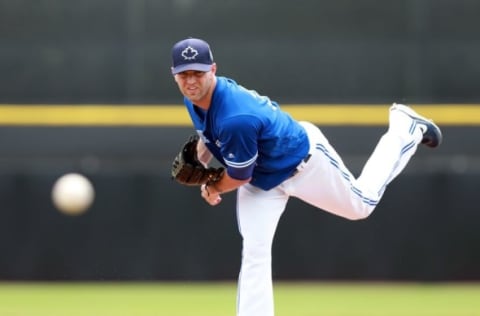
Game #4: April 6, 2016 – 1:10 ET
J.A. Happ (11-8, 3.61 ERA, 3.41 FIP) vs.
Matt Moore (3-4, 5.43 ERA, 4.82 FIP)
Wednesday’s matinee finale should see a battle of the lefties in J.A. Happ and Matt Moore, giving Blue Jays fans their first look of the Second Happ Age.
After signing very early in free agency for $36 million over three years, Happ has enjoyed a fairly quiet spring. With his spot in the rotation guaranteed, Happ pitched just 10.1 innings over three games in Major League spring training, instead doing some of his work on the Minor League side.
The question with him, of course, is which version of the 2015 Happ the Blue Jays are getting their hands on.
After starting out sluggishly with the Seattle Mariners (where he was dealt for Michael Saunders), his season took off following a trade deadline deal to the Pittsburgh Pirates where pitching guru Ray Searage awaited with open arms. In the 11 starts following the trade, Happ post a 1.85 ERA with 9.6 K/9 (well above his career strikeout rate).
In Moore, the Blue Jays are facing another southpaw that’s difficult to project. After holding great promise earlier in his career, the 26-year old enters 2016 looking to re-establish himself in his first full season after recovering from Tommy John surgery.
Next: 5 reasons that this is the Blue Jays year
After returning midway through last season, Moore struggled out of the gates with his newly-altered mechanics, pitching 63.0 Major League innings with a 5.43 ERA. He threw another 51.1 innings on the Minor League side (A+, AAA), so in terms of workload, it was a nice return for Moore.
The key for Moore will be rediscovering the excellent changeup that he threw nearly 20% of the time pre-TJ. He will top out around 93 miles-per-hour with his fastball, also featuring a seldom-used cutter and a curveball that rests around 80.
It’s encouraging to see his velocity back after the surgery, but for a pitcher like Moore who allows a lot of balls hit in the air, the Blue Jays lineup is one dangerous matchup.